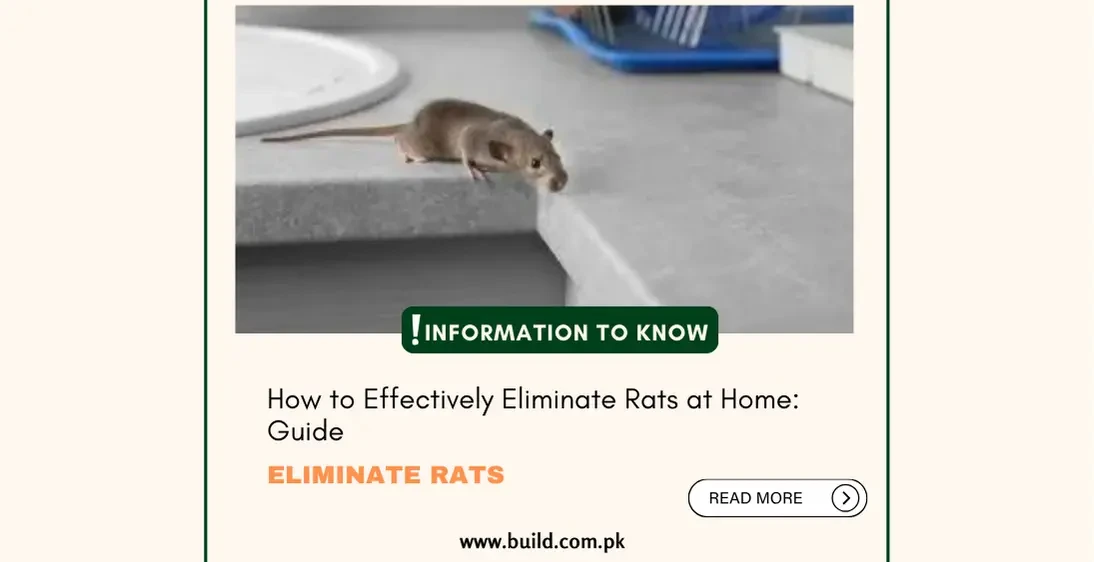How to Effectively Eliminate Rats at Home: Guide

Information:
Dealing with a rat infestation at home can be a challenging
and unpleasant experience. Rats can cause damage to property, spread diseases,
and pose health risks to you and your family. If you're looking for effective
methods to eliminate rats from your home, it's important to approach the
situation with care and consideration. In this detailed guide, we'll explore
various methods and strategies to kill rats at home safely and effectively.
Identifying Rat Infestation Signs
Before taking action to address a rat infestation, it's
essential to accurately identify the signs of rats in your home. This step
helps determine the severity of the problem and where to focus control efforts.
Look out for the following signs:
Droppings: Rat droppings are dark, cylindrical, and typically
found in concentrated areas along walls, in corners, or near food sources.
Fresh droppings indicate recent rat activity.
Gnaw Marks: Rats have strong teeth that leave behind gnaw
marks on wood, plastic, electrical wires, and other materials. Look for gnawing
on baseboards, furniture, and food packaging.
Nesting Materials: Rats create nests using shredded paper,
fabric, insulation, or other soft materials in secluded areas like attics,
basements, or behind appliances.
Strange Noises: Rats are nocturnal and may produce
scratching, scurrying, or squeaking sounds, especially at night, in walls,
ceilings, or under floors.
Tracks and Smudge Marks: Rats often leave greasy marks or rub
against walls and surfaces as they navigate through your home, leaving behind
tracks or smudges.
Identifying these signs will provide critical information for
targeting areas of activity and selecting the most effective control methods.
Safe and Effective Methods to Eliminate Rats
When dealing with a rat infestation, prioritize methods that
are safe, humane, and effective. Here are detailed descriptions of various
approaches:
Traps:
Traps are widely used for rat control and offer a humane way
to capture and kill rats. Different types of traps include:
Snap Traps: These traditional traps are designed to kill rats
instantly with a spring-loaded mechanism triggered by bait. Use peanut butter
or cheese as bait and place traps along walls or near rat activity areas.
Electronic Traps: Battery-operated electronic traps deliver a
lethal electric shock when a rat enters, providing a quick and humane kill.
They are safe to use around pets and children and minimize direct contact with
rodents.
Glue Traps: Glue boards or traps capture rats by sticking
them to a strong adhesive surface. While effective, this method may not be
considered humane due to prolonged suffering and is best used in areas
inaccessible to pets and children.
Place traps strategically in areas where rats are active,
such as along walls, near entry points, or where signs of activity are evident.
Rodenticides:
Rodenticides are chemical baits designed to kill rats. It's
essential to use caution and follow safety guidelines:
Anticoagulant Baits: These baits contain chemicals that
interfere with blood clotting, leading to internal bleeding and eventual death.
Place baits in tamper-resistant bait stations to prevent accidental ingestion
by pets and wildlife.
Single-Dose Baits: These baits deliver a lethal dose of
poison to rats, causing rapid death. Follow label instructions carefully, and
use in areas inaccessible to children and non-target animals.
Rodenticides should be used as a last resort and with caution
to minimize risks to non-target wildlife and pets.
Natural Repellents:
Consider using natural repellents to deter rats from your
home:
Peppermint Oil: Rats dislike the strong scent of peppermint
oil. Soak cotton balls in peppermint oil and place them in areas frequented by
rats, such as entry points, or near nesting sites.
Mothballs: The odor of mothballs can repel rats. Place
mothballs in enclosed spaces or entry points to discourage rodents from
entering.
Seal Entry Points:
Prevent future rat infestations by sealing entry points and
securing your home:
Close Gaps: Seal cracks, holes, and openings in walls,
floors, doors, and windows using steel wool, wire mesh, or caulk to prevent
rats from entering.
Trim Vegetation: Keep trees and shrubs trimmed away from your
home to eliminate potential hiding spots for rats and prevent them from gaining
access to the roof or attic.
Conclusion:
Dealing with a rat infestation requires a proactive and strategic approach. By identifying signs of infestation, using safe and effective killing methods, and taking preventive measures, you can successfully eliminate rats from your home and protect your living environment. If unsure or uncomfortable, don't hesitate to seek professional pest control assistance for comprehensive and long-term solutions. Remember, maintaining a clean and well-sealed home is key to preventing future rat problems.









